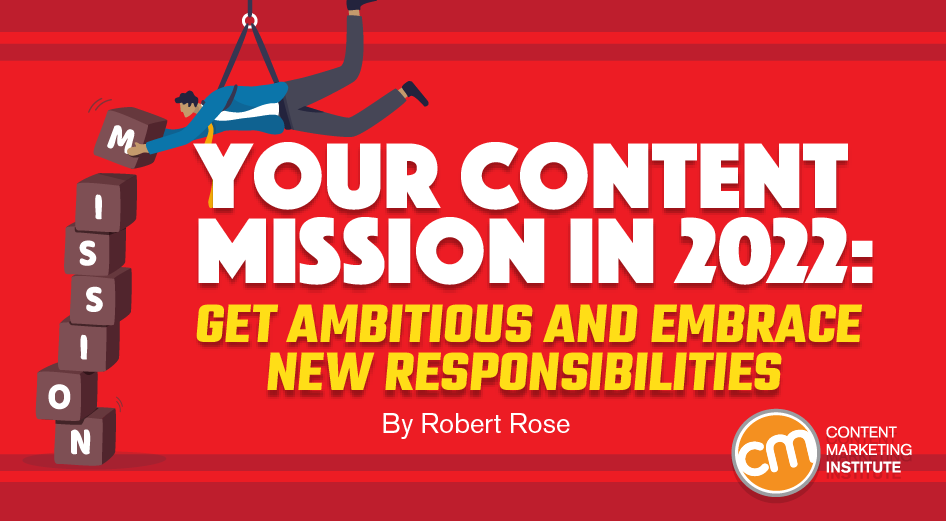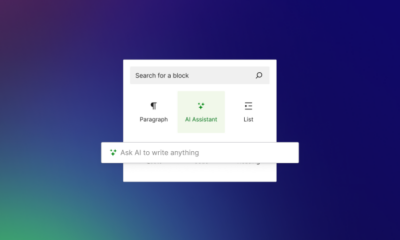MARKETING
Get Ambitious and Embrace New Responsibilities

We spend a lot of time at CMI thinking about the purpose of content in business. It sounds funny. The purpose of content in business?
When we start work with a company on putting a functional plan around their content, a senior leader in the business (usually somebody in finance or operations) often says, “Isn’t that word content too big? Doesn’t that mean everything we do?”
“Yup. It does,” I reply, followed by an awkward moment of silence.
Without realizing it, they’ve unconsciously made the argument of why it is valuable to sort out the function of content in their company.
Now, of course, we need to back off a little from saying it covers “everything.” What we’re going to solve in a consulting engagement, one of our events, a webinar, a blog post, or even CMI University can’t encompass “everything.”
So, I explain to the inquisitor that what we mean is by developing a strategy for content you can equate content with communication. If your content is intended to communicate and deliver value to our audiences, then it is worth putting a plan around the creation of those things. That’s a content strategy.
It’s worth putting a plan around your #content that’s designed to deliver value to your audience. That’s a #ContentStrategy, says @Robert_Rose via @CMIContent. Click To Tweet
More than a decade ago, my good friend and CMI founder Joe Pulizzi put a stake in the ground for what would become known as content marketing. I loved that he said it so very plainly: Marketers now have the opportunity to provide “truly relevant and useful content to prospects and customers to help them solve their issues.”
The beauty of that definition is in the stated purpose. Content is purposely designed to be more than classic marketing and advertising, where content’s purpose is to persuade people to become or stay customers. In the case of content marketing, content is created to help. Full stop. In other words, the content is valuable to the audience without any context of the brand or its products.
Joe’s original definition is still reflected on CMI’s definitions page. To this day, it remains in the No. 1 position for Google searchers who ask, “What is content marketing?”
But, of course, like everything in marketing, our beloved practice has evolved.
Tracking the evolving content ecosystem
Well before content marketing entered our lexicon, the phrase “content strategy” was a key – if not fairly niche – part of business strategy. The term arguably predates digital, but the internet, large websites, structured authoring (i.e., separating the content from its presentation), and dynamically assembling meaningful content gave momentum to the practice of content strategy.
Over eight years ago, I leaned in on my background in enterprise content and attempted to stratify the approaches of both content strategy and content marketing. Content marketing is often the biggest opportunity, the largest gap in capabilities, or the most misunderstood of practices. But it is but one piece in the larger strategic content puzzle.
Content marketing always has (and will always be) a subset of content strategy. That said, both practices have the same goal – effective, efficient business communication.
More recently, new subsets of content marketing have emerged. Whether it’s branded content, brand journalism, native advertising, or even customer experience, we’ve written to separate the signal from the noise on those approaches.
Here we are in 2022, and let’s just say the last two years have been – well – difficult. It’s been hard to get our bearings, hard to set a long-term strategy, and hard to know where to make our biggest investments.
But those disruptions also have been an accelerator. Changes in our digital capabilities, the media by which we consume content, the talent pool and skillsets, and where we do our work have pushed us to innovate. Content leaders, strategists, managers, writers, SEO specialists, technologists, AI practitioners, and data scientists have all found the optimal ways to make content in marketing and communications a scalable, measured, and exciting approach for business.
2022 is the time to make #content a scalable, measured, and exciting approach for business, says @Robert_Rose via @CMIContent. Click To Tweet
Now we sit on the cusp of the third era of the web.
Can you even imagine what things like crypto, blockchain, DAOs (decentralized autonomous organizations), and the metaverse technologies will do to our practice?
No. You can’t. Not yet.
From opportunity to responsibility
We’re evolving at CMI, too. We’re humbled at the level of innovation. In the last 12 months, we’ve seen:
So, we still fundamentally believe companies have the opportunity to operate like media companies. But, in 2022, it’s not only an opportunity; it’s a responsibility to act more like media companies.
In 2022, it’s not only an opportunity; it’s a responsibility of companies to act more like media companies, says @Robert_Rose via @CMIContent. Click To Tweet
The subtitle of Edelman’s seminal 2022 Trust Barometer is “Societal Leadership is now a Core Function of Business.” As the authors write, “We have studied trust for more than 20 years and believe that it is the ultimate currency in the relationship that all institutions – business, governments, NGOs and media – build with their stakeholders.”
Think about that quote as I refer back to Joe’s 2009 definition of content marketing: “truly relevant and useful content to prospects and customers to help them solve their issues.”
Content marketing is at the heart of any business that wants to build trust.
#ContentMarketing is at the heart of any business that wants to build trust, says @Robert_Rose via @CMIContent. Click To Tweet
Where CMI is headed
If I can humble brag for a minute, at CMI, we have been fighting the good fight for the last decade. We haven’t always gotten it right, but we’ve had a front-row seat to what’s actually going on in the world of business content.
Over the last two years, my team and I have worked directly with more than 60 of the Fortune 1,000 companies. The research team recently produced our 12th annual content marketing research that surveyed about 1,400 marketers around the globe. Lastly, despite the pandemic and lockdowns, Content Marketing World continued last year with thousands of marketers from more than 50 countries gathering both virtually and in person to talk about the strategic approach of content.
Here’s the point: We see what’s really going on in the community. And our community is you – the practitioner. We see you.
As we move into 2022 and beyond, you’ll see us focus on some of these three major observations:
1. Content marketing and content strategy will merge
Successful businesses take the function of enterprise content seriously. They recognize content is communication, and making it functional is more than just copywriting, thought leadership, storytelling, metadata structures, content management, SEO, or workflow processes. It is all those things.
Successful businesses recognize making #content functional is more than just copywriting, thought leadership, storytelling, metadata structures, SEO, workflow processes, says @Robert_Rose via @CMIContent. Click To Tweet
We see organizations moving beyond the one or two ad-hoc content marketing practitioners to holistic, specialized teams focused on strategic content. Prepare for the great merger of marketing content, content marketing, and content operations. Content is a business strategy. Copywriting, storytelling, measurement, and structured content operations will become a single, functional strategy.
To achieve that, content marketers will need to upskill in strategy, technology, and content structures. Content strategists will need to upskill in media operations, creative, journalism, storytelling. And everybody will need to upskill into measurement design.
2. The best content teams will enable the story
Spoiler alert: If you think you can check the content strategy box by installing a content studio of writers, designers, podcasters, and designers who are chartered to build internal capacity for the increasing demand for content, think again.
Robert’s content law is this: The need for more content expands in direct proportion with the number of resources allocated to it.
A successful strategy is integrated. Content creation, management, and measurement must be organizational strengths. All teams need to be empowered to create content for their audiences. The secret superpower of a content team is being the arbiter of good – to create, help, guide, and direct (when necessary) individuals at the edges of the business to be consistent and engaging storytellers.
I promise you CMI will be talking a lot about this in the coming months.
3. Goals and measurability will continue to frustrate
The through-line in the struggle for content to gain traction in the business is how to support goals and measure progress towards them.
The double-edged sword is that when content grows to be a business strategy, it becomes critically important to measure, and it becomes much more complex to measure.
It is inherently difficult to precisely define value in measuring communication clearly across all parts of the customer’s journey. We have seen some performance frameworks emerge, and certainly, more will become available.
However, the operational model itself may become one of the most important measures of success. In other words, when content strategy becomes the foundational model for communication in the business, the content must work harder. Content must be reusable and scalable across multiple approaches. Thus, businesses will need to measure performance as it relates to the audience’s response and how effectively you’re saying it.
What this means for you
Our goal remains largely the same as it has since Joe wrote his seminal blog post – to advance the practice of content marketing. But if this mission is our North Star, we must enhance our focus with better telescopes.
And your future is the focus of all of this. In the ’20s, a modern content practitioner:
- Is a leader in the organization’s communication strategy. The team is not an internal, on-demand content vending machine but part of the fabric of every customer experience with the business.
- Understands the differences and intricacies of all operational approaches of content in the business, from content marketing and content operations to branded content, native advertising, and anything else that inherently drives the creation of media-powered customer experiences as a business strategy.
- Aligns goals and measurement with the strategy. The content team members of today and tomorrow build audiences through owned media experiences that can be monetized in multiple ways. They drive promotional execution of content for short-term advertising campaigns. They drive engagement and shares on social media and organic search traffic from smart earned media and word-of-mouth strategies. But they also support visibility, transparency, and internal communication of the lifecycle of content – from ideation to creation, management, activation, promotion, and even archival.
- Supports every part of the customer’s journey. The content teams are not just top-of-the-funnel sales enablement teams. They are not just SEO-focused teams driving brand awareness. They are not just customer-support organizations managing how-to videos or customer events. Content teams are the experts in delivering audience value at every stage of the customer journey.
#Content teams are the experts in delivering audience value at every stage of the customer journey, says @Robert_Rose via @CMIContent. Click To Tweet
And thus, CMI expands our mission, our editorial coverage, our teaching, and our learning as well. You will see more coverage on topics such as content operations, structured content, technology, as well as educational content on native advertising, branded content, storytelling. And you may even see us diving into the rabbit hole of Web 3.0 and its implications on our practice.
It’s a unified family of specific, related approaches to the strategic use of media in our business.
CMI is here to support you – the content teams, the leaders, the practitioners, the influencers – all of you who make content work in business.
Cover image by Joseph Kalinowski/Content Marketing Institute


















You must be logged in to post a comment Login